|
Topics
Introduction
Problems Freedom Knowledge Mind Life Chance Quantum Entanglement Scandals Philosophers Mortimer Adler Rogers Albritton Alexander of Aphrodisias Samuel Alexander William Alston Anaximander G.E.M.Anscombe Anselm Louise Antony Thomas Aquinas Aristotle David Armstrong Harald Atmanspacher Robert Audi Augustine J.L.Austin A.J.Ayer Alexander Bain Mark Balaguer Jeffrey Barrett William Barrett William Belsham Henri Bergson George Berkeley Isaiah Berlin Richard J. Bernstein Bernard Berofsky Robert Bishop Max Black Susan Blackmore Susanne Bobzien Emil du Bois-Reymond Hilary Bok Laurence BonJour George Boole Émile Boutroux Daniel Boyd F.H.Bradley C.D.Broad Michael Burke Jeremy Butterfield Lawrence Cahoone C.A.Campbell Joseph Keim Campbell Rudolf Carnap Carneades Nancy Cartwright Gregg Caruso Ernst Cassirer David Chalmers Roderick Chisholm Chrysippus Cicero Tom Clark Randolph Clarke Samuel Clarke Anthony Collins August Compte Antonella Corradini Diodorus Cronus Jonathan Dancy Donald Davidson Mario De Caro Democritus William Dembski Brendan Dempsey Daniel Dennett Jacques Derrida René Descartes Richard Double Fred Dretske Curt Ducasse John Earman Laura Waddell Ekstrom Epictetus Epicurus Austin Farrer Herbert Feigl Arthur Fine John Martin Fischer Frederic Fitch Owen Flanagan Luciano Floridi Philippa Foot Alfred Fouilleé Harry Frankfurt Richard L. Franklin Bas van Fraassen Michael Frede Gottlob Frege Peter Geach Edmund Gettier Carl Ginet Alvin Goldman Gorgias Nicholas St. John Green Niels Henrik Gregersen H.Paul Grice Ian Hacking Ishtiyaque Haji Stuart Hampshire W.F.R.Hardie Sam Harris William Hasker R.M.Hare Georg W.F. Hegel Martin Heidegger Heraclitus R.E.Hobart Thomas Hobbes David Hodgson Shadsworth Hodgson Baron d'Holbach Ted Honderich Pamela Huby David Hume Ferenc Huoranszki Frank Jackson William James Lord Kames Robert Kane Immanuel Kant Tomis Kapitan Walter Kaufmann Jaegwon Kim William King Hilary Kornblith Christine Korsgaard Saul Kripke Thomas Kuhn Andrea Lavazza James Ladyman Christoph Lehner Keith Lehrer Gottfried Leibniz Jules Lequyer Leucippus Michael Levin Joseph Levine George Henry Lewes C.I.Lewis David Lewis Peter Lipton C. Lloyd Morgan John Locke Michael Lockwood Arthur O. Lovejoy E. Jonathan Lowe John R. Lucas Lucretius Alasdair MacIntyre Ruth Barcan Marcus Tim Maudlin James Martineau Nicholas Maxwell Storrs McCall Hugh McCann Colin McGinn Michael McKenna Brian McLaughlin John McTaggart Paul E. Meehl Uwe Meixner Alfred Mele Trenton Merricks John Stuart Mill Dickinson Miller G.E.Moore Ernest Nagel Thomas Nagel Otto Neurath Friedrich Nietzsche John Norton P.H.Nowell-Smith Robert Nozick William of Ockham Timothy O'Connor Parmenides David F. Pears Charles Sanders Peirce Derk Pereboom Steven Pinker U.T.Place Plato Karl Popper Porphyry Huw Price H.A.Prichard Protagoras Hilary Putnam Willard van Orman Quine Frank Ramsey Ayn Rand Michael Rea Thomas Reid Charles Renouvier Nicholas Rescher C.W.Rietdijk Richard Rorty Josiah Royce Bertrand Russell Paul Russell Gilbert Ryle Jean-Paul Sartre Kenneth Sayre T.M.Scanlon Moritz Schlick John Duns Scotus Albert Schweitzer Arthur Schopenhauer John Searle Wilfrid Sellars David Shiang Alan Sidelle Ted Sider Henry Sidgwick Walter Sinnott-Armstrong Peter Slezak J.J.C.Smart Saul Smilansky Michael Smith Baruch Spinoza L. Susan Stebbing Isabelle Stengers George F. Stout Galen Strawson Peter Strawson Eleonore Stump Francisco Suárez Richard Taylor Kevin Timpe Mark Twain Peter Unger Peter van Inwagen Manuel Vargas John Venn Kadri Vihvelin Voltaire G.H. von Wright David Foster Wallace R. Jay Wallace W.G.Ward Ted Warfield Roy Weatherford C.F. von Weizsäcker William Whewell Alfred North Whitehead David Widerker David Wiggins Bernard Williams Timothy Williamson Ludwig Wittgenstein Susan Wolf Xenophon Scientists David Albert Philip W. Anderson Michael Arbib Bobby Azarian Walter Baade Bernard Baars Jeffrey Bada Leslie Ballentine Marcello Barbieri Jacob Barandes Julian Barbour Horace Barlow Gregory Bateson Jakob Bekenstein John S. Bell Mara Beller Charles Bennett Ludwig von Bertalanffy Susan Blackmore Margaret Boden David Bohm Niels Bohr Ludwig Boltzmann John Tyler Bonner Emile Borel Max Born Satyendra Nath Bose Walther Bothe Jean Bricmont Hans Briegel Leon Brillouin Daniel Brooks Stephen Brush Henry Thomas Buckle S. H. Burbury Melvin Calvin William Calvin Donald Campbell John O. Campbell Sadi Carnot Sean B. Carroll Anthony Cashmore Eric Chaisson Gregory Chaitin Jean-Pierre Changeux Rudolf Clausius Arthur Holly Compton John Conway Simon Conway-Morris Peter Corning George Cowan Jerry Coyne John Cramer Francis Crick E. P. Culverwell Antonio Damasio Olivier Darrigol Charles Darwin Paul Davies Richard Dawkins Terrence Deacon Lüder Deecke Richard Dedekind Louis de Broglie Stanislas Dehaene Max Delbrück Abraham de Moivre David Depew Bernard d'Espagnat Paul Dirac Theodosius Dobzhansky Hans Driesch John Dupré John Eccles Arthur Stanley Eddington Gerald Edelman Paul Ehrenfest Manfred Eigen Albert Einstein George F. R. Ellis Walter Elsasser Hugh Everett, III Franz Exner Richard Feynman R. A. Fisher David Foster Joseph Fourier George Fox Philipp Frank Steven Frautschi Edward Fredkin Augustin-Jean Fresnel Karl Friston Benjamin Gal-Or Howard Gardner Lila Gatlin Michael Gazzaniga Nicholas Georgescu-Roegen GianCarlo Ghirardi J. Willard Gibbs James J. Gibson Nicolas Gisin Paul Glimcher Thomas Gold A. O. Gomes Brian Goodwin Julian Gough Joshua Greene Dirk ter Haar Jacques Hadamard Mark Hadley Ernst Haeckel Patrick Haggard J. B. S. Haldane Stuart Hameroff Augustin Hamon Sam Harris Ralph Hartley Hyman Hartman Jeff Hawkins John-Dylan Haynes Donald Hebb Martin Heisenberg Werner Heisenberg Hermann von Helmholtz Grete Hermann John Herschel Francis Heylighen Basil Hiley Art Hobson Jesper Hoffmeyer John Holland Don Howard John H. Jackson Ray Jackendoff Roman Jakobson E. T. Jaynes William Stanley Jevons Pascual Jordan Eric Kandel Ruth E. Kastner Stuart Kauffman Martin J. Klein William R. Klemm Christof Koch Simon Kochen Hans Kornhuber Stephen Kosslyn Daniel Koshland Ladislav Kovàč Leopold Kronecker Bernd-Olaf Küppers Rolf Landauer Alfred Landé Pierre-Simon Laplace Karl Lashley David Layzer Joseph LeDoux Gerald Lettvin Michael Levin Gilbert Lewis Benjamin Libet David Lindley Seth Lloyd Werner Loewenstein Hendrik Lorentz Josef Loschmidt Alfred Lotka Ernst Mach Donald MacKay Henry Margenau Lynn Margulis Owen Maroney David Marr Humberto Maturana James Clerk Maxwell John Maynard Smith Ernst Mayr John McCarthy Barbara McClintock Warren McCulloch N. David Mermin George Miller Stanley Miller Ulrich Mohrhoff Jacques Monod Vernon Mountcastle Gerd B. Müller Emmy Noether Denis Noble Donald Norman Travis Norsen Howard T. Odum Alexander Oparin Abraham Pais Howard Pattee Wolfgang Pauli Massimo Pauri Wilder Penfield Roger Penrose Massimo Pigliucci Steven Pinker Colin Pittendrigh Walter Pitts Max Planck Susan Pockett Henri Poincaré Michael Polanyi Daniel Pollen Ilya Prigogine Hans Primas Giulio Prisco Zenon Pylyshyn Henry Quastler Adolphe Quételet Pasco Rakic Nicolas Rashevsky Lord Rayleigh Frederick Reif Jürgen Renn Giacomo Rizzolati A.A. Roback Emil Roduner Juan Roederer Robert Rosen Frank Rosenblatt Jerome Rothstein David Ruelle David Rumelhart Michael Ruse Stanley Salthe Robert Sapolsky Tilman Sauer Ferdinand de Saussure Jürgen Schmidhuber Erwin Schrödinger Aaron Schurger Sebastian Seung Thomas Sebeok Franco Selleri Claude Shannon James A. Shapiro Charles Sherrington Abner Shimony Herbert Simon Dean Keith Simonton Edmund Sinnott B. F. Skinner Lee Smolin Ray Solomonoff Herbert Spencer Roger Sperry John Stachel Kenneth Stanley Henry Stapp Ian Stewart Tom Stonier Antoine Suarez Leonard Susskind Leo Szilard Max Tegmark Teilhard de Chardin Libb Thims William Thomson (Kelvin) Richard Tolman Giulio Tononi Peter Tse Alan Turing Robert Ulanowicz C. S. Unnikrishnan Nico van Kampen Francisco Varela Vlatko Vedral Vladimir Vernadsky Clément Vidal Mikhail Volkenstein Heinz von Foerster Richard von Mises John von Neumann Jakob von Uexküll C. H. Waddington Sara Imari Walker James D. Watson John B. Watson Daniel Wegner Steven Weinberg August Weismann Paul A. Weiss Herman Weyl John Wheeler Jeffrey Wicken Wilhelm Wien Norbert Wiener Eugene Wigner E. O. Wiley E. O. Wilson Günther Witzany Carl Woese Stephen Wolfram H. Dieter Zeh Semir Zeki Ernst Zermelo Wojciech Zurek Konrad Zuse Fritz Zwicky Presentations ABCD Harvard (ppt) Biosemiotics Free Will Mental Causation James Symposium CCS25 Talk Evo Devo September 12 Evo Devo October 2 Evo Devo Goodness Evo Devo Davies Nov12 |
Biosemiotics
This web page is adapted from slides presented in June 2015 at the U.C. Berkeley Symposium -
"From Information to Semiosis." You may link to the dynamic presentation slides here - informationphilosopher.com/presentations/Biosemiotics,. There you can advance forward and backward in the presentation. Below the slides are static in this one vertical page. 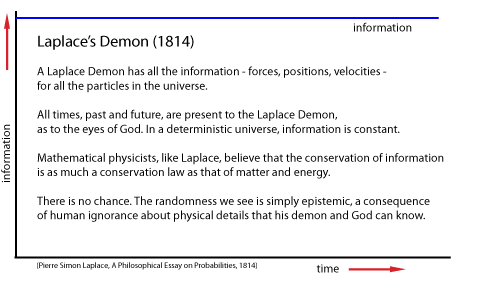
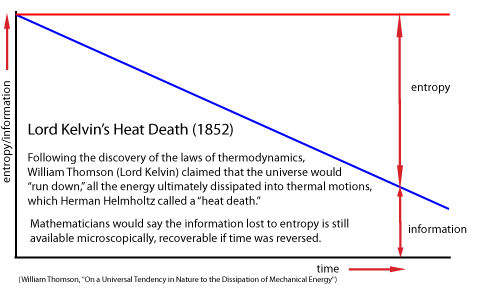
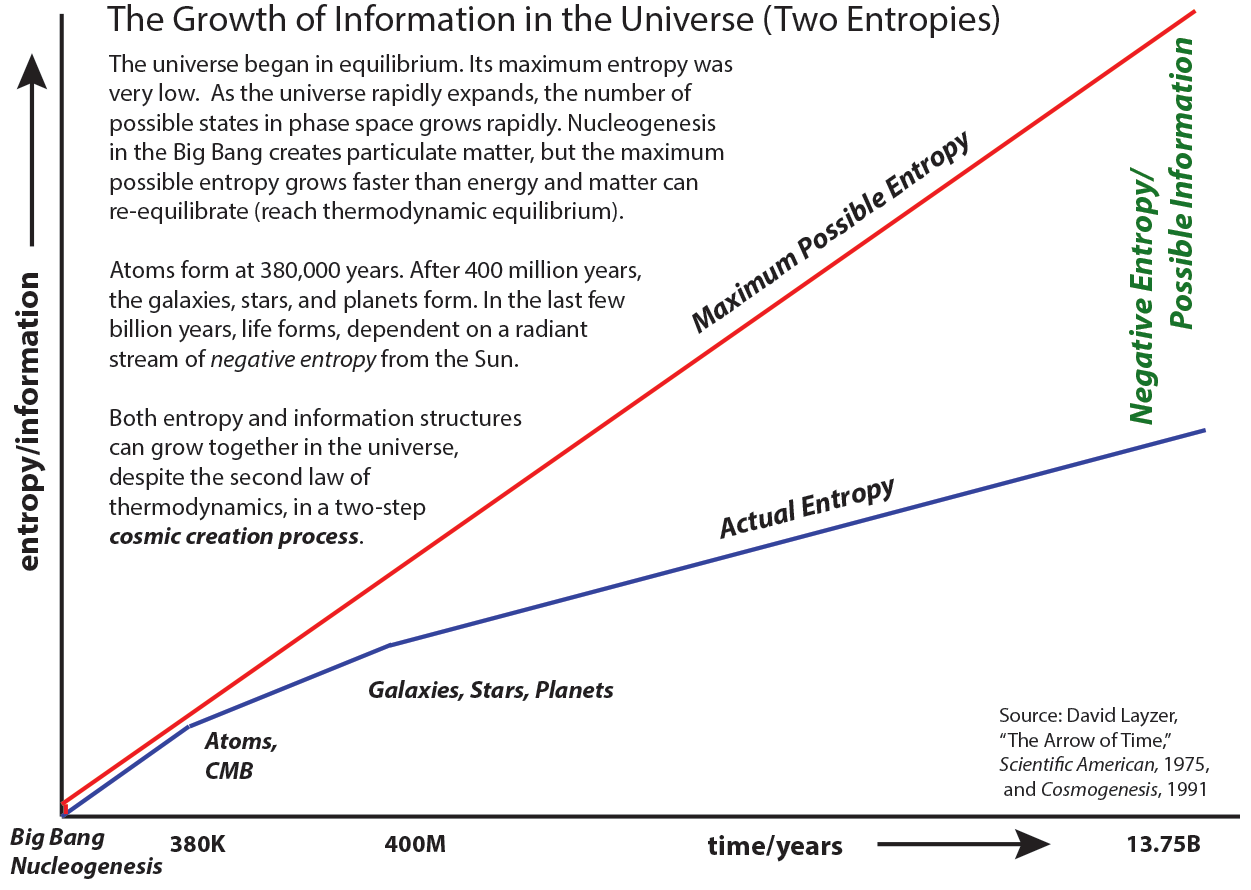
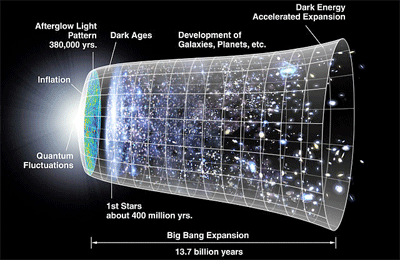
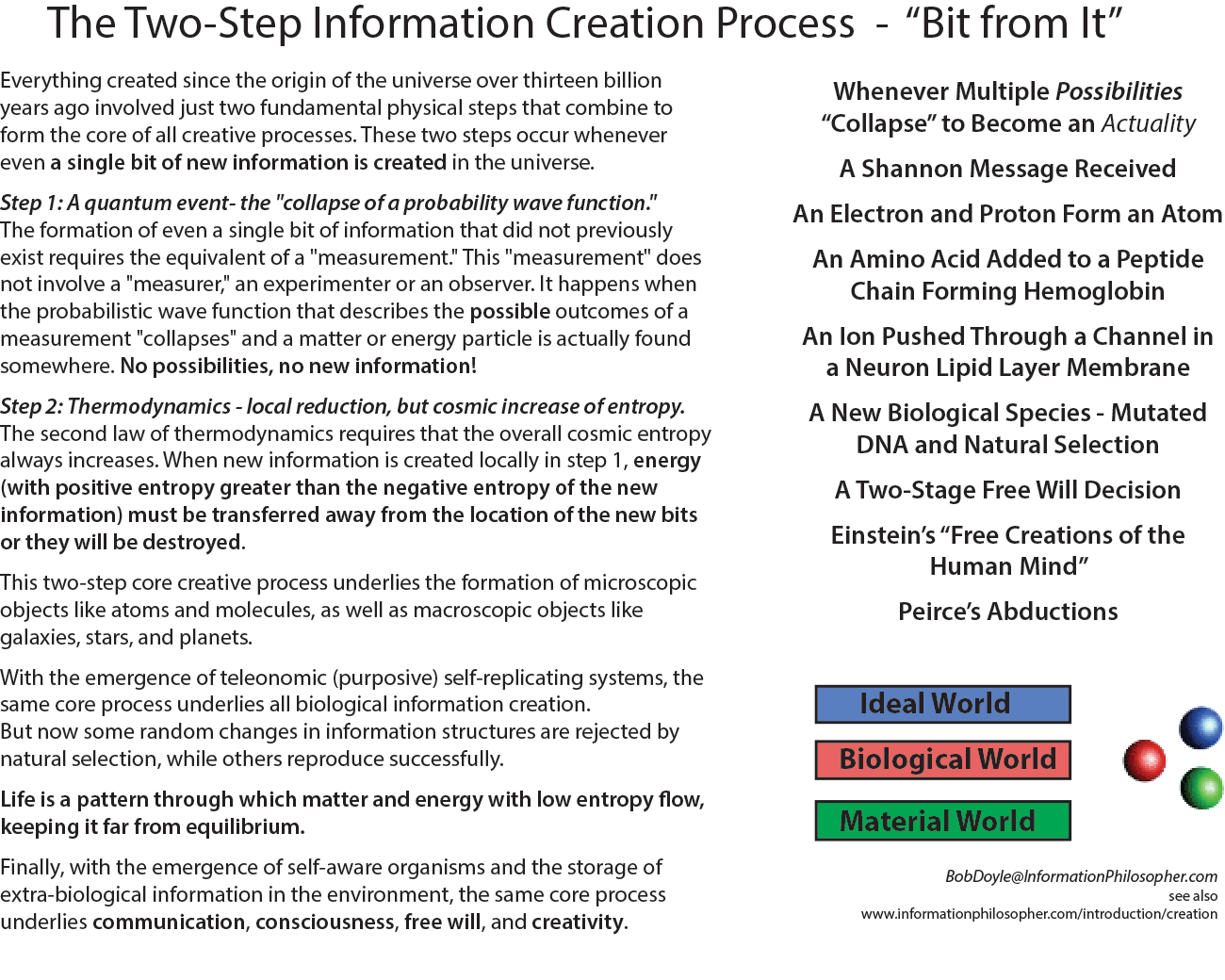
The Experience Recorder and Reproducer
What is the minimal mind model that a primitive organism needs to process the information needed for biosemiotic interpretant power?
The neuroscientist Donald Hebb said in 1949 that "neurons that fire together wire together." Information philosopher Bob Doyle suggests that “neurons that have been wired together will fire together.” The ERR Recorder: Neurons become wired together (strengthening their synaptic connections to other neurons) during an organism’s experiences, across multiple sensory and limbic systems. The ERR Reproducer: Later firing of even a part of the previously wired neurons can stimulate firing of all or part of many original complexes, thus "playing back" the original experiences (including the very important emotional reactions to the original experiences) producing William James’ “blooming, buzzing, confusion.” Man is not a machine. And the mind is not a computer. The ERR model stands in contrast to the popular cognitive science or “computational” model of a mind as a digital computer with a "central processor" or even many "parallel processors." No algorithms or stored programs are needed for the ERR model. There is nothing comparable to the addresses and data buses used to store and retrieve information in a digital computer. The mind is a biological information processor. 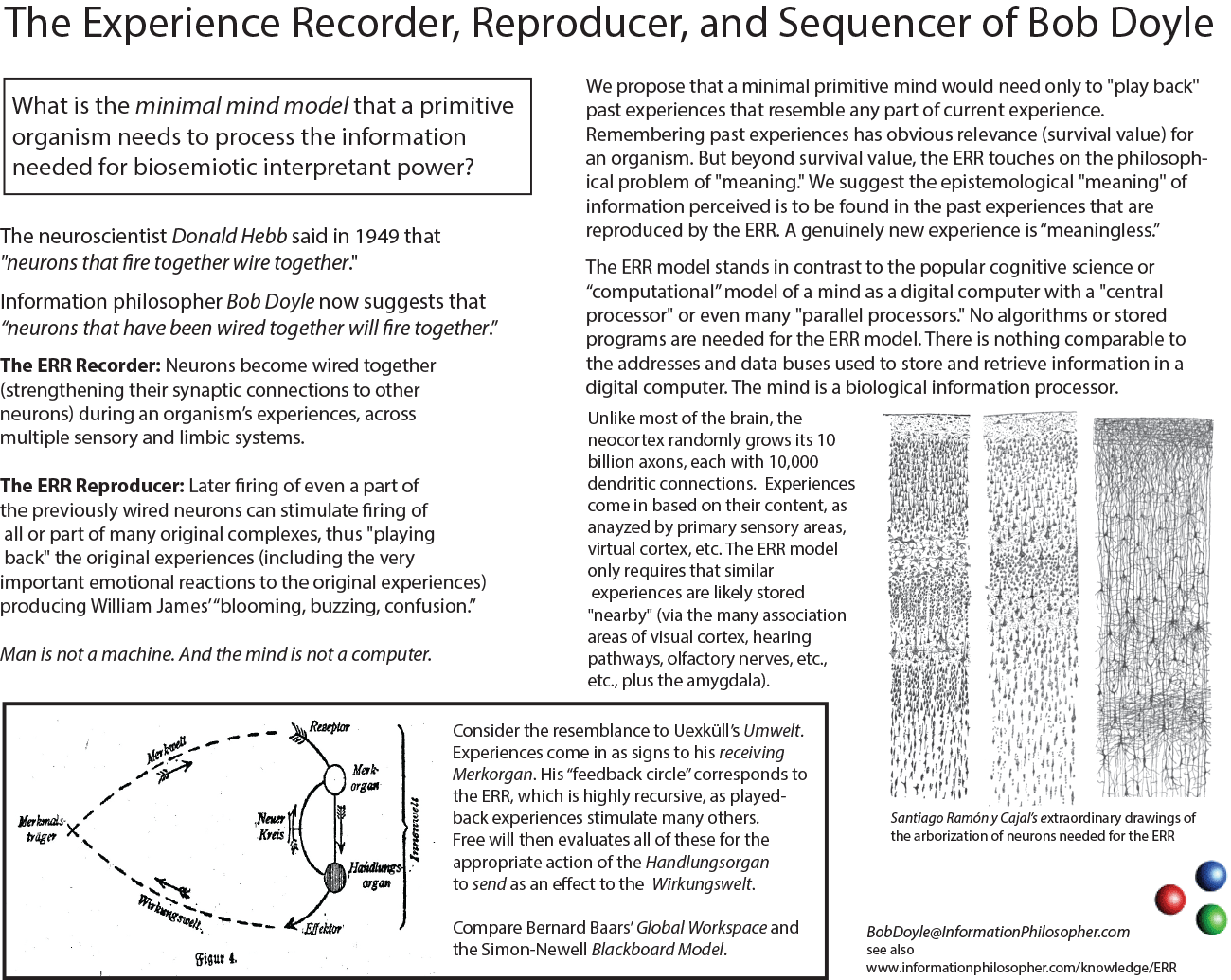
The ERR and Consciousness
At a conference on Free Will in Barcelona in 2010, Martin Heisenberg asked if I could develop proposals for evolutionary steps between his
bacterial level and the human levels of free will. I decided to regard them as levels of consciousness about experiences in
the Experience Recorder and Reproducer
Instinctive Consciousness - by animals with little or no
learning capability. Automatic reactions to environmental conditions are transmitted genetically. Information about past experiences (by prior generations of the organism) is only present implicitly
in the inherited reactions. (Konrad Lorenz- “What’s a priori in the phenotype was a posteriori in the genotype.”)
Learned Consciousness - for animals whose past experiences
guide current choices (along with inherited experience). Conscious, but mostly habitual, reactions are developed through experience, including instruction by parents and peers.
Predictive Consciousness - A sequencer in the ERR system
can play back beyond the current situation, allowing the organism
to use imagination and foresight to evaluate the future
consequences of its possible choices.
Reflective (Normative) Consciousness– in which conscious
deliberation about individual values and the shared values of the species influences the choice of alternative behaviors.
The Two-Stage Model of Free Will
If we are determined, we are not free.
Philosophers Think Free Will Acts at a Moment

The Temporal Sequence of first Free, then Will

Most philosophers and scientists are compatibilists, who want their actions to be caused by their reasons, motives, feelings, etc. and not be random. They think free will is compatible with determinism. In the two-stage model, ontological chance or indeterminism of quantum mechanics is limited to the free generation of alternative possibilities. In the second stage, the evaluation of alternatives is an adequately (statistically) determined process that leads to a willed act of self-determination. This should be all that a compatibilist could want. It adds the fact that our actions are not pre-determined from moments before the decision process begins. 
Downward Causation
Is it illogical to claim that biological information processing systems can have one-way causality?
The philosopher of mind Jaegwon Kim claims that the physical world is "causally closed," that the mind is epiphenomenal, that every mental event has a
corresponding physical event that is the efficient cause of our actions. Mental events are redundant!
A study of the behavior of atoms and molecules in ribosomes in normal cells and in ion channels in neurons shows that semiotic information control flows only downward at the
biological/chemical and mental/biological interfaces.
The lower level atoms and molecules are shown to be in thermal equilibrium. Their paths do not contain the information (Gibbs/Boltzmann “molecular order”) that would be needed for lower levels to be “in charge” of the upper levels. The intuitions of the emergentists are confirmed that biology cannot be reduced to chemistry and physics, nor can mind be reduced to the brain/body.
Biosemiotic control has one-way causality.

A Ribosome at the Biology/Matter Boundary
An Ion Pump at the Mind/Brain Boundary
Biological Information Processing Turns Matter Into Life
When a ribosome assembles 330 amino acids in four symmetric polypeptide chains (globins), each globin traps an iron atom in a heme group at the center to form the hemoglobin protein. This is downward causal control of the amino acids, the heme groups, and the iron atoms by the ribosome. The ribosome is an example of Erwin Schrödinger's emergent "order out of order," life "feeding on the negative entropy" of digested food.
The random motions of the molecules in the cytosol insure that there is no organized "bottom-up" causation directing the ribosome.
Notice the absurdity of the idea that the random motions of the transfer RNA molecules (green in the video at right), each holding a single amino acid (red), are carrying pre-determined information of where they belong in the protein.
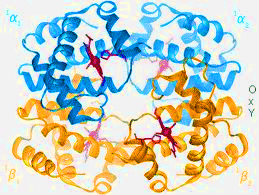
Claude Shannon's Communication of Information
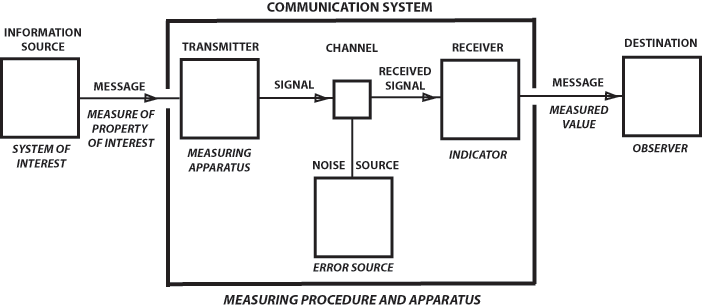
Roman Jakobson's Communications Functions
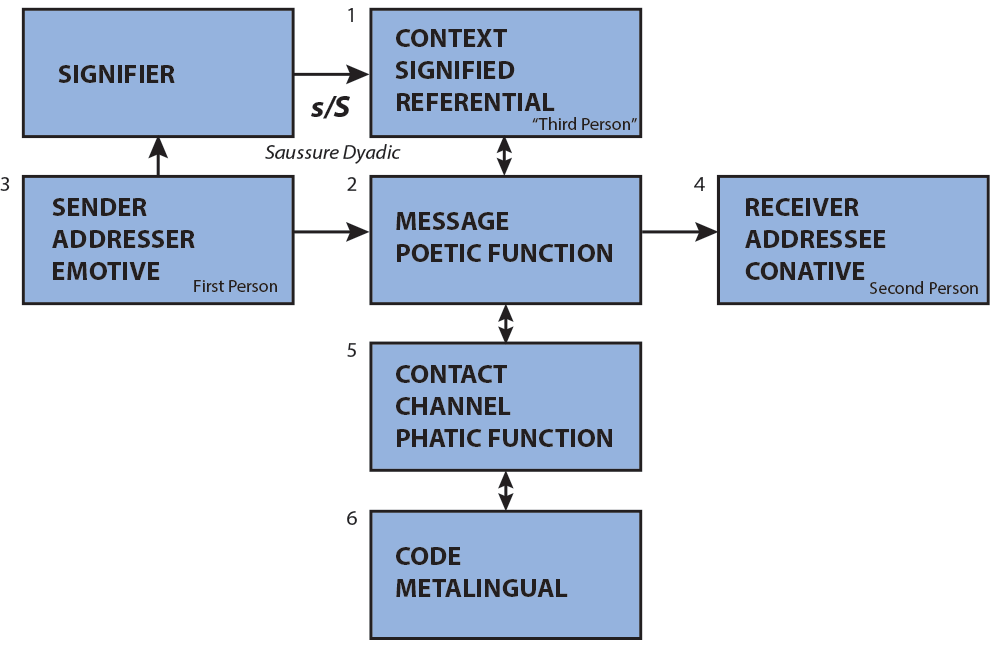
Umberto Eco's Communications Model

The information of the message is only reduced by the addressee when he selects a definite interpretation.He also wrote a paradoxical example of the problem facing the interpretant: i vitelli dei romani sono belli
Charles Sanders Peirce's Theory of Semiotics
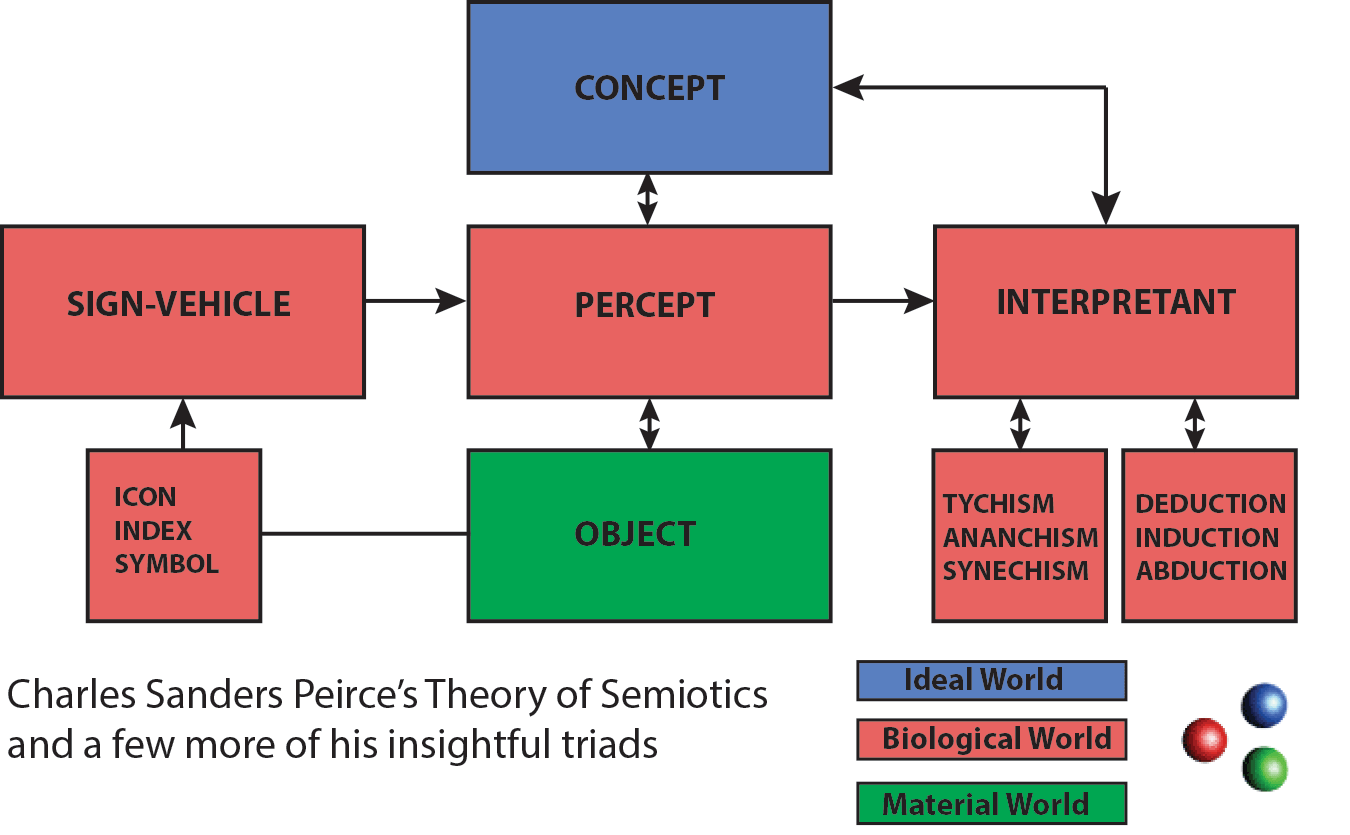
Three Worlds
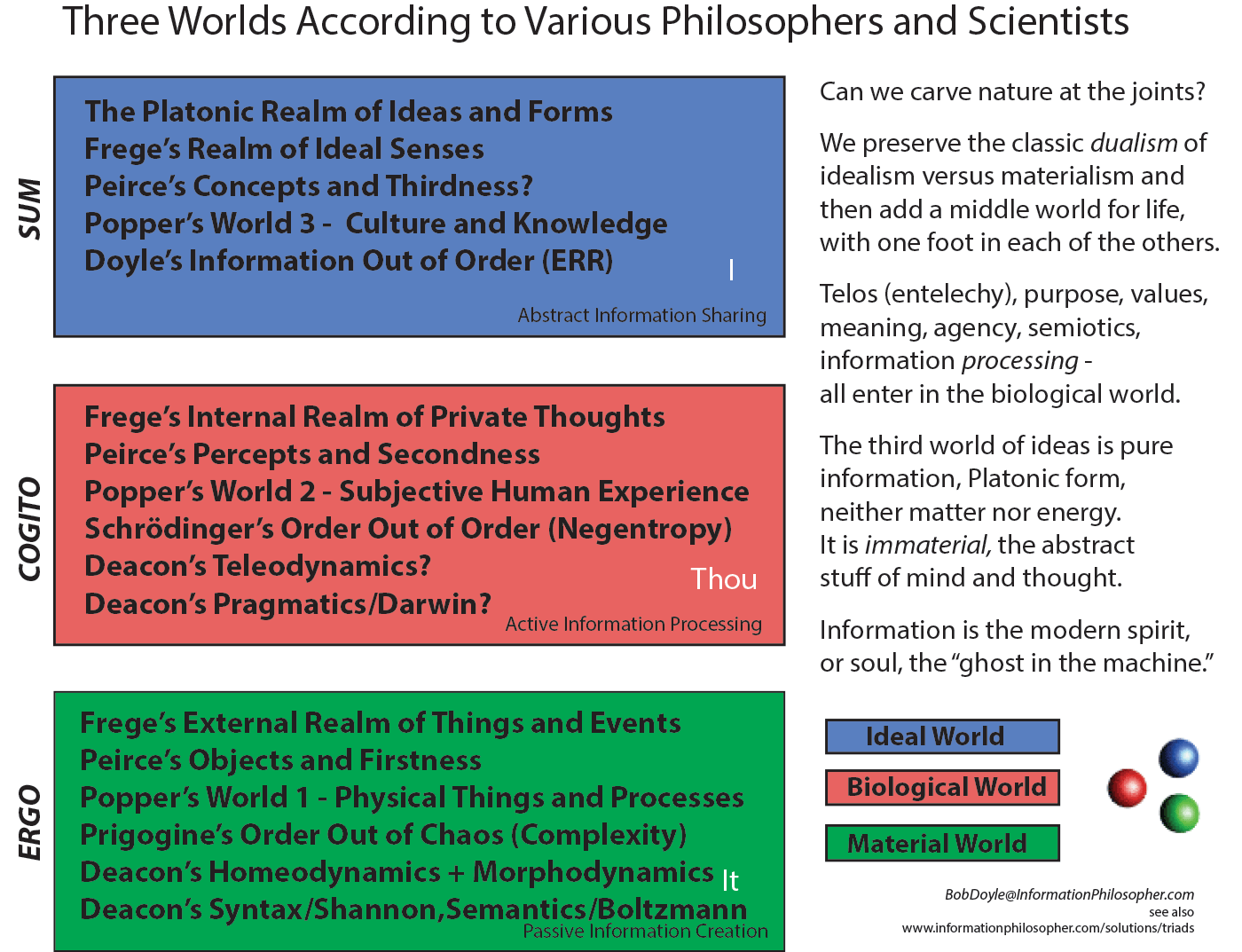
A Biosemiotic Flow Chart
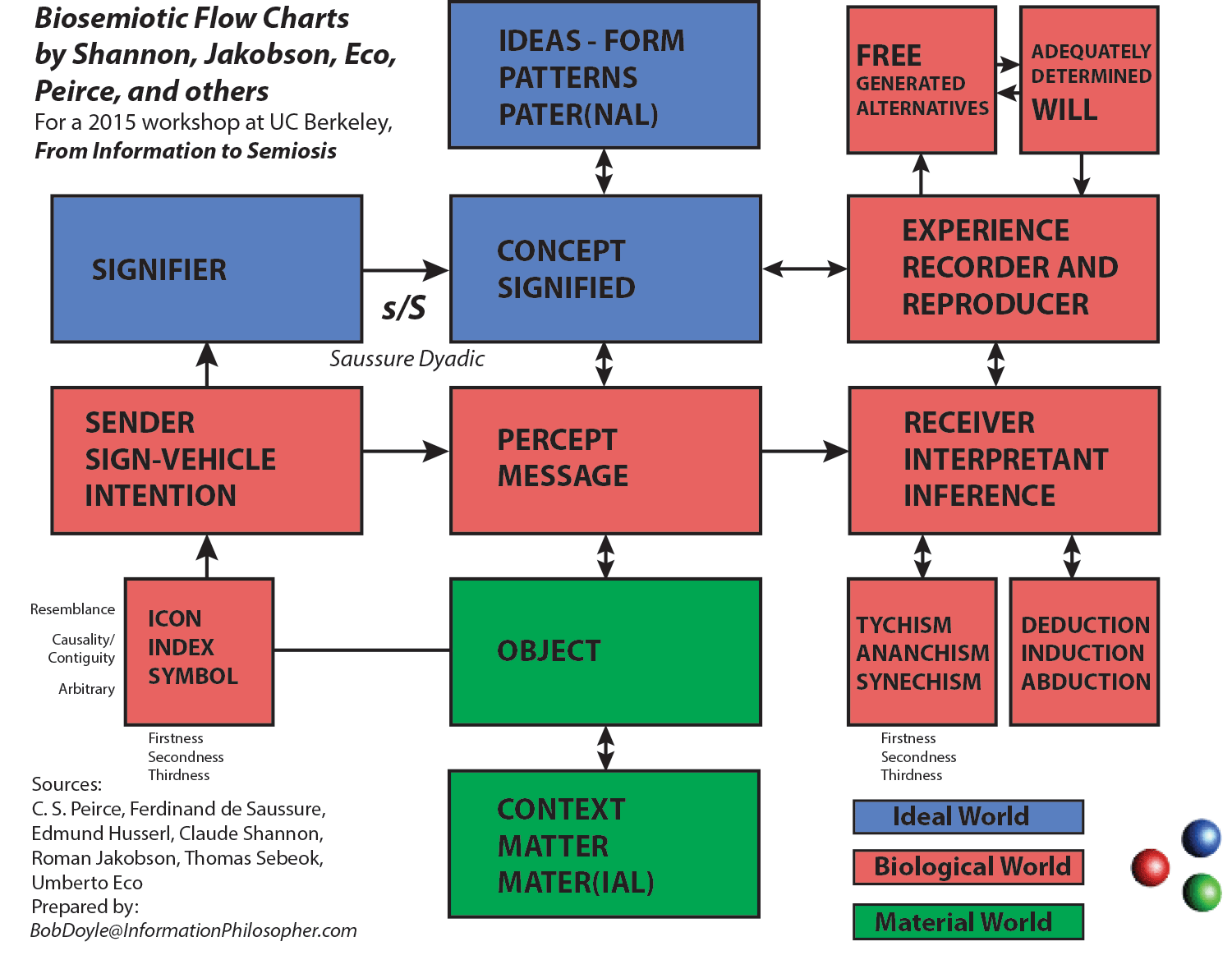
Concepts and Percepts (without Objects)
Immanuel Kant wrote this famous chiasmos (figure of speech)
Gedanken ohne Inhalt sind leer.Charles Sanders Peirce adapted this for a beautifully symmetric chiasmos about the fundamental dualism. If Materialism without Idealism is blind,With a nod to Kant and Peirce, we can say Kantcepts without Peircepts are empty.And although Freedom and Values are not a dualism, they too require one another and we can observe, Freedom without Values is Absurd (Continental Existentialism). Link to this presentation: http://informationphilosopher.com/presentations/Biosemiotics/ Email me: BobDoyle@InformationPhilosopher.com or rodoyle@fas.harvard.edu |